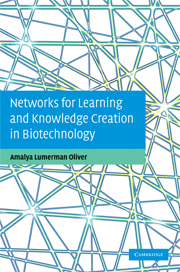Book contents
- Frontmatter
- Contents
- List of figures
- List of tables
- Acknowledgements
- Introduction
- 1 Networks, collaborations, and learning and knowledge creation
- 2 The biotechnology industry through the lenses of organizational and networks scholarship
- 3 New organizational forms for knowledge creation in biotechnology
- 4 Scientific entrepreneurship
- 5 Science and discoveries in the context of private and public knowledge creation and learning
- 6 The search for university–industry collaborations: linear and chaotic networking processes
- 7 Trust in collaborations and the social structure of academic research
- 8 Organizational learning and strategic alliances: recombination and duality of competition and collaboration
- 9 Further directions for understanding interorganizational collaborations and learning
- References
- Index
9 - Further directions for understanding interorganizational collaborations and learning
Published online by Cambridge University Press: 04 July 2009
- Frontmatter
- Contents
- List of figures
- List of tables
- Acknowledgements
- Introduction
- 1 Networks, collaborations, and learning and knowledge creation
- 2 The biotechnology industry through the lenses of organizational and networks scholarship
- 3 New organizational forms for knowledge creation in biotechnology
- 4 Scientific entrepreneurship
- 5 Science and discoveries in the context of private and public knowledge creation and learning
- 6 The search for university–industry collaborations: linear and chaotic networking processes
- 7 Trust in collaborations and the social structure of academic research
- 8 Organizational learning and strategic alliances: recombination and duality of competition and collaboration
- 9 Further directions for understanding interorganizational collaborations and learning
- References
- Index
Summary
The aim of this book is to offer a complex mapping of actors, forms, levels, processes, and domain issues associated with issues of learning and knowledge creation in alliances and collaborations within the biotechnology industry. The mapping is not exhaustive or conclusive as it leads to further research directions, new analytical concepts, foci directions, and interrelations that need to be examined. In many respects, the book offers a taste of the many important “flavors” associated with studies on learning, collaborations, and networks in the biotechnology industry. In this final chapter, the general findings and arguments presented in the book are summarized, and a few important directions that future research might explore further are suggested.
The first chapter introduced the concepts of “collaboration” and “learning” in the context of the biotechnology industry. Understanding these concepts is related to issues of levels of analysis, which are needed for understanding of the knowledge creation and learning processes within and between organizations. The aim of the chapter was to establish the analytic elements used in the book and to exemplify the complexity involved in studying exchanges that are embedded in multilevels and multi-units.
The organizational literature on alliances and learning in the biotechnology industry was reviewed in Chapter 2, which introduced the main actors in the industry and highlighted some of the research on them. In addition, the chapter provided some comparison with what is known about other knowledge-intensive industries.
- Type
- Chapter
- Information
- Networks for Learning and Knowledge Creation in Biotechnology , pp. 211 - 226Publisher: Cambridge University PressPrint publication year: 2009



